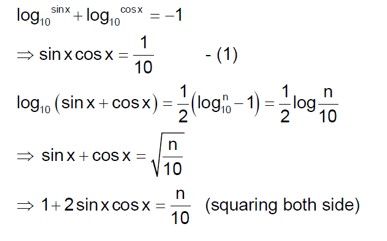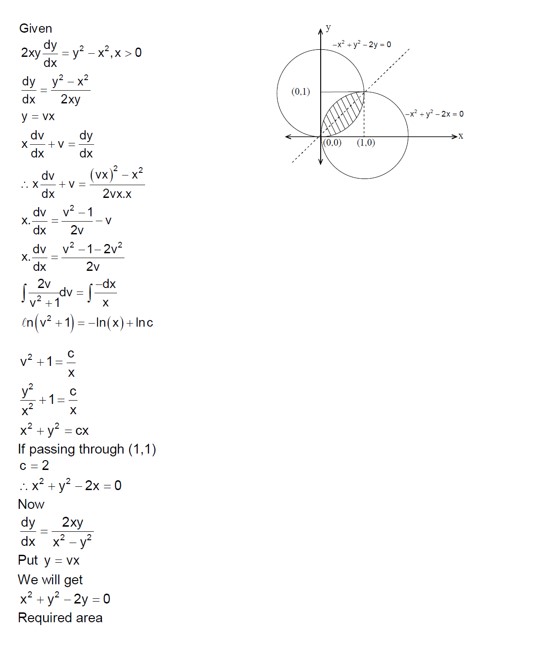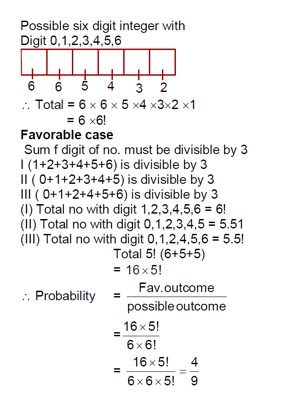Maths
Get insights from 6.5k questions on Maths, answered by students, alumni, and experts. You may also ask and answer any question you like about Maths
Follow Ask QuestionQuestions
Discussions
Active Users
Followers
New answer posted
2 months agoContributor-Level 9
f (x) = (4a - 3) (x + ln5) + 2 (a - 7)cot (x/2)sin² (x/2)
= (4a - 3) (x + ln5) + (a - 7)sin (x)
f' (x) = (4a - 3) + (a - 7)cos (x)
For critical points f' (x) = 0
cos (x) = - (4a - 3) / (a - 7) = (3 - 4a) / (a - 7)
⇒ -1 ≤ (3 - 4a) / (a - 7) ≤ 1
Solving this inequality leads to:
⇒ a ∈ [4/3, 2]
New answer posted
2 months agoContributor-Level 9
(|x| - 3)|x + 4| = 6

(-x - 3) (- (x + 4) = 6
(x + 3) (x + 4) = 6 ⇒ x² + 7x + 12 = 6 ⇒ x² + 7x + 6 = 0
(x + 1) (x + 6) = 0 ⇒ x = -6 (since x < -4)
Case (ii) -4 ≤ x < 0
(-x - 3) (x + 4) = 6
⇒ -x² - 7x - 12 = 6
⇒ x² + 7x + 18 = 0
The discriminant is D = 7² - 4 (1) (18) = 49 - 72 < 0, so no real solution.
Case (iii) x ≥ 0
(x - 3) (x + 4) = 6
⇒ x² + x - 12 = 6
⇒ x² + x - 18 = 0
x = [-1 ± √ (1² - 4 (1) (-18)] / 2 = [-1 ± √73] / 2
Since x ≥ 0 ⇒ x = (√73 - 1) / 2
Only two solutions.
New answer posted
2 months agoContributor-Level 9
Variance of a, b, c & a+2, b+2, c+2, are same.
Given: b = a + c (i)
d² = (1/3) (a² + b² + c²) - [ (a+b+c)/3]²
as a + c = b
d² = (1/3) (a² + b² + c²) - (2b/3)²
9d² = 3 (a² + b² + c²) - 4b²
⇒ b² = 3 (a² + c²) - 9d²
New answer posted
2 months agoContributor-Level 9
log? /? [ (|z|+11)/ (|z|-1)²] < 2
(|z|+11)/ (|z|-1)² > (1/2)²
(|z|+11)/ (|z|-1)² > 1/4
⇒ 4|z| + 44 > |z|² - 2|z| + 1
⇒ |z|² - 6|z| - 43 < 0
⇒ |z| - 7 ≤ 0
∴ |z|max = 7
New answer posted
2 months agoContributor-Level 10
P (x) = x² + bx + c.
Given ∫? ¹ P (x) dx = 1.
∫? ¹ (x² + bx + c) dx = [x³/3 + bx²/2 + cx] from 0 to 1 = 1/3 + b/2 + c = 1.
2 + 3b + 6c = 6 => 3b + 6c = 4 - (i)
When P (x) is divided by (x-2), the remainder is 5. So, P (2) = 5.
(2)² + b (2) + c = 5 => 4 + 2b + c = 5 => 2b + c = 1 - (ii)
From (ii), c = 1 - 2b. Substitute into (i):
3b + 6 (1 - 2b) = 4
3b + 6 - 12b = 4
-9b = -2 => b = 2/9.
c = 1 - 2 (2/9) = 1 - 4/9 = 5/9.
We need to find 9 (b+c).
9 (2/9 + 5/9) = 9 (7/9) = 7.
New answer posted
2 months agoContributor-Level 10
dy/dx + (tanx)y = sinx. This is a linear differential equation.
Integrating Factor (I.F.) = e^ (∫tanx dx) = e^ (ln|secx|) = secx.
The solution is y * I.F. = ∫ (sinx * I.F.) dx + C.
y * secx = ∫ (sinx * secx) dx = ∫tanx dx = ln|secx| + C.
Given y (0) = 0.
0 * sec (0) = ln|sec (0)| + C => 0 = ln (1) + C => C = 0.
So, y * secx = ln (secx).
y = cosx * ln (secx).
At x = π/4:
y = cos (π/4) * ln (sec (π/4) = (1/√2) * ln (√2) = (1/√2) * (1/2)ln (2) = ln (2) / (2√2).
Taking an Exam? Selecting a College?
Get authentic answers from experts, students and alumni that you won't find anywhere else
Sign Up on ShikshaOn Shiksha, get access to
- 65k Colleges
- 1.2k Exams
- 679k Reviews
- 1800k Answers





